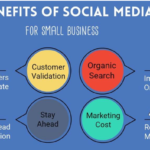What Is Social Media Marketing? A Beginner’s Guide
Social media marketing has become a powerful way for businesses of all sizes to reach prospects and customers. Whether you’re a solopreneur just starting or a large company looking to boost brand awareness, social media marketing can help you connect with your audience, increase visibility, and drive sales.
In this beginner’s guide, we’ll explain social media marketing, why it’s important, and how to get started.
What Is Social Media Marketing?
Social media marketing is the use of social media platforms to promote products or services, build brand awareness, engage with audiences, and drive website traffic or conversions. It involves creating and sharing content—text, images, videos, and more—on platforms like:
Facebook
Instagram
Twitter/X
LinkedIn
TikTok
Pinterest
YouTube
This type of marketing includes both organic (free) content strategies and paid advertising options.
Why Social Media Marketing Matters
Here are a few compelling reasons why businesses are investing in social media:
Increased Brand Awareness: Regular posting keeps your brand top-of-mind.
Better Customer Engagement: Direct interactions build stronger relationships.
Higher Website Traffic: Social posts can drive users to your blog, products, or services.
Cost-Effective Advertising: Paid social is often more affordable than traditional ads.
Valuable Insights: Social analytics help you understand your audience and improve your strategy.
Key Components of Social Media Marketing
1. Strategy
Every good campaign starts with a plan:
What are your goals? (e.g., brand awareness, leads, sales)
Who is your audience?
What platforms make sense for your business?
2. Content Creation
You’ll need a mix of content types:
Images and infographics
Short-form videos (e.g., Reels, TikToks)
Stories and live streams
Blog post promotion
Educational and entertaining content
3. Scheduling and Publishing
Consistency is key. Use tools like:
Buffer
Hootsuite
Later
Meta Business Suite
4. Engagement
Respond to comments, messages, and mentions. Social media is a two-way street.
5. Analytics and Reporting
Track metrics like:
Engagement rate
Follower growth
Click-through rates (CTR)
Conversion rates
Use platform insights or tools like Google Analytics and Sprout Social.
Getting Started: Step-by-Step
Choose your platforms based on where your audience spends time.
Set up business profiles with branded visuals and clear bios.
Develop a content plan with goals, posting schedule, and topics.
Create and post consistently, using tools to help with scheduling.
Engage daily: like, comment, reply, and build community.
Track your results and adjust your strategy as needed.
Final Thoughts
Social media marketing is an essential part of modern digital marketing. It’s accessible, versatile, and offers massive potential to grow your brand and connect with your audience in a meaningful way.
Start small, stay consistent, and keep learning. With time and the right strategy, your social media efforts can yield big results.




